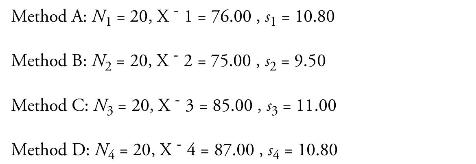To evaluate the effectiveness of four different teaching methods, algebra student's are randomly assigned to one of
Question:
To evaluate the effectiveness of four different teaching methods, algebra student's are randomly assigned to one of four methods (A, B, C, or D) and then given a test. The descriptive statistics for each of the four methods are provided below. Determine whether there are any differences in the test scores of the four methods.

a. State the null and alternative hypotheses \(\left(\mathrm{H}_{0}\right.\) and \(\left.\mathrm{H}_{1}\right)\).
b. Make a decision about the null hypothesis.
1, Calculate the degrees of freedom \((d f)\).
2, Set alpha (a), identify the critical value, and state a decision rule.
3, Calculate the \(F\)-ratio \((F)\) and create an ANOVA summary table.
4, Make a decision whether to reject the null hypothesis.
5, Determine the level of significance.
6, Calculate a measure of effect size \(\left(R^{2}\right)\).
c. Draw a conclusion from the analysis.
Step by Step Answer:

Fundamental Statistics For The Social And Behavioral Sciences
ISBN: 9781483318790
1st Edition
Authors: Howard T. Tokunaga





